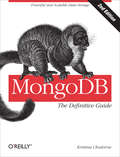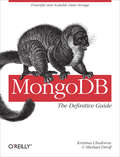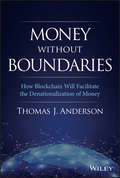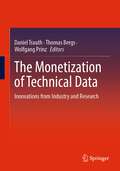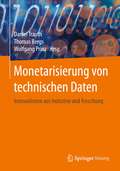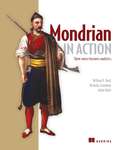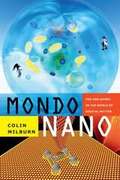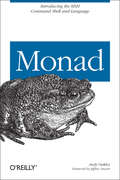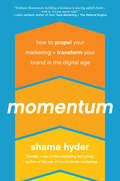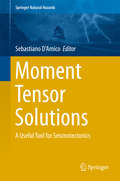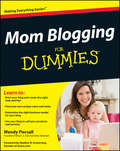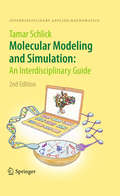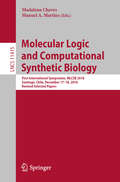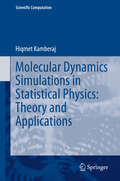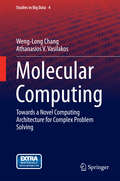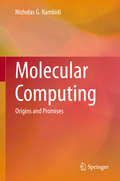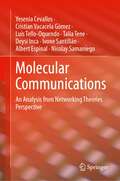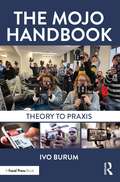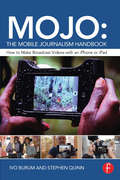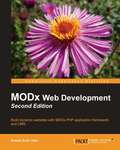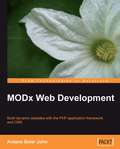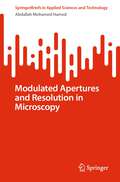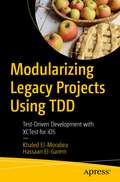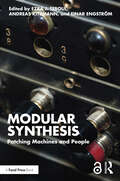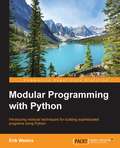- Table View
- List View
MongoDB: Powerful and Scalable Data Storage
by Kristina ChodorowManage the huMONGOus amount of data collected through your web application with MongoDB. This authoritative introduction--written by a core contributor to the project--shows you the many advantages of using document-oriented databases, and demonstrates how this reliable, high-performance system allows for almost infinite horizontal scalability. This updated second edition provides guidance for database developers, advanced configuration for system administrators, and an overview of the concepts and use cases for other people on your project. Ideal for NoSQL newcomers and experienced MongoDB users alike, this guide provides numerous real-world schema design examples. Get started with MongoDB core concepts and vocabulary Perform basic write operations at different levels of safety and speed Create complex queries, with options for limiting, skipping, and sorting results Design an application that works well with MongoDB Aggregate data, including counting, finding distinct values, grouping documents, and using MapReduce Gather and interpret statistics about your collections and databases Set up replica sets and automatic failover in MongoDB Use sharding to scale horizontally, and learn how it impacts applications Delve into monitoring, security and authentication, backup/restore, and other administrative tasks
MongoDB: The Definitive Guide
by Michael Dirolf Kristina ChodorowHow does MongoDB help you manage a huMONGOus amount of data collected through your web application? With this authoritative introduction, you'll learn the many advantages of using document-oriented databases, and discover why MongoDB is a reliable, high-performance system that allows for almost infinite horizontal scalability. Written by engineers from 10gen, the company that develops and supports this open source database, MongoDB: The Definitive Guide provides guidance for database developers, advanced configuration for system administrators, and an overview of the concepts and use cases for other people on your project. Learn how easy it is to handle data as self-contained JSON-style documents, rather than as records in a relational database. Explore ways that document-oriented storage will work for your project Learn how MongoDB's schema-free data model handles documents, collections, and multiple databases Execute basic write operations, and create complex queries to find data with any criteria Use indexes, aggregation tools, and other advanced query techniques Learn about monitoring, security and authentication, backup and repair, and more Set up master-slave and automatic failover replication in MongoDB Use sharding to scale MongoDB horizontally, and learn how it impacts applications Get example applications written in Java, PHP, Python, and Ruby
Money Without Boundaries: How Blockchain Will Facilitate the Denationalization of Money
by Thomas AndersonDiscover how blockchain will facilitate a new currency that will transcend space and time Largely inspired by The Denationalization of Money by Fredrich Hayek, Money Without Boundaries’ ideological foundation is also inspired by economists and thought leaders like Milton Friedman and Irving Fisher, advancements in capital markets over the past 50 years, and the convergence of old and new technologies. Author Thomas J. Anderson explains how blockchain acts as the filter and the glue, making it all possible. Compared with other currencies, blockchain-managed money markets are more straightforward and transparent. It is easier to monitor, understand, and assess the quality of their "full-faith and credit." Money Without Boundaries shows how not only money, but also the process of borrowing and lending, will evolve to be conducted in a 100% trusted, secure, transparent, open architecture environment. Anderson begins with a history of money and discusses the rise of cryptocurrency, concluding with a comparison of decentralized money markets to all other alternatives. Money without Boundaries: • Demonstrates how blockchain technology allows full transparency • Explains how blockchain makes it possible for money to be fully commoditized • Explains how this fully market-based, decentralized, self-regulating system has vast implications throughout the global financial system • Shows how everyone will benefit when they have the opportunity to compete on “full faith in credit” If you are interested in cryptocurrency, money, monetary theory, or understanding how the applied uses of blockchain technology will change your everyday life, this is essential reading.
The Monetization of Technical Data: Innovations from Industry and Research
by Daniel Trauth Thomas Bergs Wolfgang PrinzThe monetization of data is a very young topic, for which there are only very few case studies. There is a lack of strategy or concept that shows decision-makers the way into the monetization of data, especially those who have discovered or are threatened by the digital transformation or Industry 4.0. Because machine data is usually unstructured and not usable without domain knowledge/metadata, the monetization of machine data has an as yet unquantifiable potential. In order to make this potential tangible, this work describes not only contributions from science, but also practical examples from industry. Based on different examples from various industries, the reader can already become part of a future data economy today. Values and benefits are described in detail.
Monetarisierung von technischen Daten: Innovationen aus Industrie und Forschung
by Daniel Trauth Thomas Bergs Wolfgang PrinzDie Monetarisierung von Daten ist per se ein sehr junges Thema, zu dem es nur sehr vereinzelt Fallbeispiele gibt. Es fehlt an einer Strategie bzw. einem Konzept, das Führungskräften den Weg in die Monetarisierung von Daten zeigt, insbesondere jenen, die die Digitale Transformation bzw. Industrie 4.0 für sich entdeckt haben oder davon bedroht sind. Weil Maschinendaten meist unstrukturiert und ohne Domänenwissen/Metadaten nicht verwertbar sind, birgt die Monetarisierung von Maschinendaten ein noch nicht abschließend bewertbares Potenzial. Um dieses Potenzial greifbar zu machen, werden in diesem Werk neben Beiträgen aus der Wissenschaft auch Praxisbeispiele aus der Industrie beschrieben. Anhand von unterschiedlichen Beispielen aus diversen Branchen kann der Leser bereits heute Teil einer zukünftigen Datenökonomie werden. Mehrwerte und Nutzen werden konkret beschrieben.
Mondrian in Action
by Julian Hyde William Back Nicholas GoodmanSummaryMondrian in Action teaches business users and developers how to use Mondrian and related tools for strategic business analysis. You'll learn how to design and populate a data warehouse and present the data via a multidimensional model. You'll follow examples showing how to create a Mondrian schema and then expand it to add basic security based on the users' roles.About the TechnologyMondrian is an open source, lightning-fast data analysis engine designed to help you explore your business data and perform speed-of-thought analysis. Mondrian can be integrated into a wide variety of business analysis applications and learning it requires no specialized technical knowledge.About this BookMondrian in Action teaches you to use Mondrian for strategic business analysis. In it, you'll learn how to organize and present data in a multidimensional manner. You'll follow apt and thoroughly explained examples showing how to create a Mondrian schema and then expand it to add basic security based on users' roles. Developers will discover how to integrate Mondrian using its olap4j Java API and web service calls via XML for Analysis.Written for developers building data analysis solutions. Appropriate for tech-savvy business users and DBAs needing to query and report on data.Purchase of the print book includes a free eBook in PDF, Kindle, and ePub formats from Manning Publications.What's InsideMondrian from the ground up—no experience requiredA primer on business analyticsUsing Mondrian with a variety of leading applicationsOptimizing and restricting business data for fast, secure analysisAbout the AuthorsWilliam D. Back is an Enterprise Architect and Director of Pentaho Services. Nicholas Goodman is a Business Intelligence pro who has authored training courses on OLAP and Mondrian. Julian Hyde founded Mondrian and is the project's lead developer.Table of ContentsBeyond reporting: business analyticsMondrian: a first lookCreating the data mart Multidimensional modeling: making analytics data accessibleHow schemas growSecuring dataMaximizing Mondrian performanceDynamic securityWorking with Mondrian and PentahoDeveloping with MondrianAdvanced analytics
Mondo Nano: Fun and Games in the World of Digital Matter
by Colin MilburnIn Mondo Nano Colin Milburn takes his readers on a playful expedition through the emerging landscape of nanotechnology, offering a light-hearted yet critical account of our high-tech world of fun and games. This expedition ventures into discussions of the first nanocars, the popular video games Second Life, Crysis, and BioShock, international nanosoccer tournaments, and utopian nano cities. Along the way, Milburn shows how the methods, dispositions, and goals of nanotechnology research converge with video game culture. With an emphasis on play, scientists and gamers alike are building a new world atom by atom, transforming scientific speculations and video game fantasies into reality. Milburn suggests that the closing of the gap between bits and atoms entices scientists, geeks, and gamers to dream of a completely programmable future. Welcome to the wild world of Mondo Nano.
Monad (AKA PowerShell)
by Andy OakleyWindows PowerShell, formerly know by its codename "Monad" and available now for Windows Server 2003, Windows XP, and Windows Vista, and soon for Exchange Server 2007 and MOM, is the future of Windows administration. From setting up automated build environments to managing 20,000 Exchange email clients in an organization, any tool that reduces the number of repetitive steps an administrator must perform, is a real win. Even better, PowerShell part of a major Microsoft initiative that aims to replace a host of Windows management tools with a single, unified shell. This is the promise of PowerShell and the reason IT professionals need to start learning how to use it today Reflecting the best of legacy tools such as bash and the Korn shell, PowerShell also breaks new ground in its command language design and its use of the object-oriented .NET Framework. And there is no better way to learn how to put PowerShell to work than to get your hands on Monad, O'Reilly's innovative, hands-on introduction to the tool. This concise 200-page book is an exciting tour of some of the new capabilities that PowerShell puts into the hands of system administrators and power users, and is the perfect complement to existing PowerShell documentation. With more than 40 hands-on activities, the book covers every angle, from using PowerShell commands and its object-oriented pipelines to querying systems, generating reports and writing scripts that automate existing tasks. Adding to the lure is the fact that the book is written by Microsoft manager, Andy Oakley with a Foreword by PowerShell architect Jeffrey Snover-so you can be certain that it's teeming with inside information. Monad lets you see for yourself how PowerShell can significantly improve your productivity. Because the PowerShell technology has wide appeal, so, too, does this compact guide. Developers, administrators, and power users alike can all benefit from its insight. If you're someone who habitually drifts toward the c-m-d keys, knows all of the switches to most command tools, or spends time authoring batch files to solve new challenges, this book is right up your alley. And if your organization plans to upgrade soon to Exchange 2007 or MOM V3, there's no time to waste. Breaking News: A PowerShell RC1 Update to the book is now available at no charge from the book's catalog page on oreilly.com!
Momentum: How to Propel Your Marketing and Transform Your Brand in the Digital Age
by Shama HyderMarketing in today's digital age has become overwhelmingly complex-but it doesn't have to be. Success lies in stepping above of the clutter and understanding the new principles of digital marketing.To this complicated and fast-moving world, bestselling author, renowned marketer, and award-winning entrepreneur Shama Hyder brings her uniquely Zen approach-separating out the critical from the trivial and the foundational rules from the ephemeral gimmicks. Offering five essential principles that crack the code on marketing successfully in today's ecosystem, Momentum: How to Propel Your Marketing and Transform Your Brand in the Digital Age will help you not only regain your sanity, but learn how to spot opportunities to grow your organization and brand in the midst of marketplace chaos.In Momentum, Shama draws on her experience guiding clients ranging from small businesses to Fortune 100s to demystify the marketing landscape and provide you with the digital foresight you need to operate effectively in an increasingly digital world. Using key principles, she demonstrates how to transform your current approach into an effective, struggle-free, ROI-driven strategy.Before you invest in another marketing strategy, take a step back. Don't waste enormous amounts of time, energy, and money on the wrong strategies and approach for your customers, industry, and market. Whether you're a young business or an established company, let Momentum teach you how to thrive.
Moment Tensor Solutions: A Useful Tool For Seismotectonics (Springer Natural Hazards Ser.)
by Sebastiano D'AmicoThis book first focuses on the explanation of the theory about focal mechanisms and moment tensor solutions and their role in the modern seismology. The second part of the book compiles several state-of-the-art case studies in different seismotectonic settings of the planet.The assessment of seismic hazard and the reduction of losses due to future earthquakes is probably the most important contribution of seismology to society. In this regard, the understanding of reliable determination seismic source and of its uncertainty can play a key role in contributing to geodynamic investigation, seismic hazard assessment and earthquake studies. In the last two decades, the use of waveforms recorded at local-to-regional distances has increased considerably. Waveform modeling has been used also to estimate faulting parameters of small-to-moderate sized earthquakes.
Mom Blogging For Dummies
by Wendy PiersallReady to start your Mom blog or enhance your existing one? This book is for you! The population of mom bloggers is growing at a stunning pace and they boast an audience of more than 23 million women reading, posting, or commenting on blogs every week. This fun and friendly guide targets moms who are looking to become a savvier blogger, build a personal brand, earn free products to review or give away, or make some extra cash through ad revenue. Named by Nielsen as one of the most influential moms online, author Wendy Piersall helps you determine the right business model for your blog and then create a professional, in-demand personal brand. Serves as a road map for the growing population of moms who are interested in creating a blog or enhancing an existing blog Explains how to define a business model, understand your reader demographics, and choose the right look and feel for your blog Addresses delicate issues such as dealing with privacy and family members who don't want to be featured on your blog Walks you through using social media to extend your personal brand, building traffic with SEO and blog networks, and having a plan and policies in place when big brands and media come calling Offers a very unintimidating format as well as the usual fun and friendly For Dummies approach This beginner guide presents baby steps for breaking into the often-daunting mom blogging community, with practical advice on how to join and become an accepted member of this exciting world.
Molecular Modeling and Simulation: An Interdisciplinary Guide
by Tamar SchlickVery broad overview of the field intended for an interdisciplinary audience; Lively discussion of current challenges written in a colloquial style; Author is a rising star in this discipline; Suitably accessible for beginners and suitably rigorous for experts; Features extensive four-color illustrations; Appendices featuring homework assignments and reading lists complement the material in the main text
Molecular Logic and Computational Synthetic Biology: First International Symposium, MLCSB 2018, Santiago, Chile, December 17–18, 2018, Revised Selected Papers (Lecture Notes in Computer Science #11415)
by Madalena Chaves Manuel A. MartinsThis book collects the revised selected proceedings of the First International Symposium in Molecular Logic and Computational Synthetic Biology ( MLCSB), held in Chile, Santiago, in December 2018. The volume contains 7 full revised papers along with 2 surveys from 19 submissions presented at the symposium. One of the goals of the MLCSB 2018 was to explore the potential of molecular logic frameworks to study the emerging behavioural patterns in biological networks, combining discrete, continuous and stochastic features, and resorting both to specific or general-purpose analysis and verification techniques.
Molecular Dynamics Simulations in Statistical Physics: Theory and Applications (Scientific Computation)
by Hiqmet KamberajThis book presents computer simulations using molecular dynamics techniques in statistical physics, with a focus on macromolecular systems. The numerical methods are introduced in the form of computer algorithms and can be implemented in computers using any desired computer programming language, such as Fortran 90, C/C++, and others. The book also explains how some of these numerical methods and their algorithms can be implemented in the existing computer programming software of macromolecular systems, such as the CHARMM program. In addition, it examines a number of advanced concepts of computer simulation techniques used in statistical physics as well as biological and physical systems. Discussing the molecular dynamics approach in detail to enhance readers understanding of the use of this method in statistical physics problems, it also describes the equations of motion in various statistical ensembles to mimic real-world experimental conditions. Intended for graduate students and research scientists working in the field of theoretical and computational biophysics, physics and chemistry, the book can also be used by postgraduate students of other disciplines, such as applied mathematics, computer sciences, and bioinformatics. Further, offering insights into fundamental theory, it as a valuable resource for expert practitioners and programmers and those new to the field.
Molecular Computing
by Weng-Long Chang Athanasios V. VasilakosThis textbook introduces a concise approach to the design of molecular algorithms for students or researchers who are interested in dealing with complex problems. Through numerous examples and exercises, you will understand the main difference of molecular circuits and traditional digital circuits to manipulate the same problem and you will also learn how to design a molecular algorithm of solving any a problem from start to finish. The book starts with an introduction to computational aspects of digital computers and molecular computing, data representation of molecular computing, molecular operations of molecular computing and number representation of molecular computing and provides many molecular algorithm to construct the parity generator and the parity checker of error-detection codes on digital communication, to encode integers of different formats, single precision and double precision of floating-point numbers, to implement addition and subtraction of unsigned integers, to construct logic operations including NOT, OR, AND, NOR, NAND, Exclusive-OR (XOR) and Exclusive-NOR (XNOR), to implement comparators, shifters, increase, decrease, and to complete two specific operations that are to find the maximum number of "1" and to find the minimum number of "1". The book is also a useful reference source to people new for the field of molecular computing.
Molecular Computing
by Nicholas G. RambidiThe question whether molecular primitives can prove to be real alternatives to contemporary semiconductor means or effective supplements extending greatly possibilities of information technologies is addressed. Molecular primitives and circuitry for information processing devices are also discussed. Investigations in molecular based computing devices were initiated in the early 1970s in the hopes for an increase in the integration level and processing speed. Real progress proved unfeasible into the 1980´s. However, recently, important and promising results were achieved. The elaboration of operational 160-kilobit molecular electronic memory patterned 1011 bits per square centimeter in the end of 90´s were the first timid steps of information processing further development. Subsequent advances beyond these developments are presented and discussed. This work provides useful knowledge to anyone working in molecular based information processing.
Molecular Communications: An Analysis from Networking Theories Perspective
by Yesenia Cevallos Cristian Vacacela Gómez Luis Tello-Oquendo Talia Tene Deysi Inca Ivone Santillán Albert Espinal Nicolay SamaniegoThis book provides a complete analysis of molecular communications systems from the paradigm of TCP/IP network stack, and it exploits network theories (e.g. independent functions of a layer into a stack, addressing, flow control, error control, and traffic control) and applies them to biological systems. The authors show how these models can be applied in different areas such as industry, medicine, engineering, biochemistry, biotechnology, computer sciences, and other disciplines. The authors then explain how it is possible to obtain enormous benefits from these practices when applied in medicine, such as enhancing current treatment of diseases and reducing the side effects of drugs and improving the quality of treatment for patients. The authors show how molecular communications systems, in contrast to existing telecommunication paradigms, use molecules as information carriers. They show how sender biological nanomachines (bio-nano machines) encode data on molecules (signal molecules) and release the molecules into the environment. They go on to explain how the molecules then travel through the environment to reach the receiver bio-nano machines, where they biochemically react with the molecules to decipher information. This book is relevant to those studying telecommunications and biomedical students, engineers, masters, PhDs, and researchers.
The Mojo Handbook: Theory to Praxis
by Ivo BurumThe Mojo Handbook: Theory to Praxis offers a detailed and engaging crash course on how to use mobile tools to create powerful journalistic stories. Drawing on both theoretical underpinnings and practical techniques, the book outlines the fundamentals of mobile journalism methods, by placing mobile storytelling within a wider context of current affairs, documentary filmmaking and public relations. The book offers expert advice for how to use storytelling skills to transform mobile content into engaging and purposeful user-generated stories for audiences. Topics covered include tips for recording dynamic video and clean audio, conducting interviews on your phone and editing and post-production processes, as well as advice on how to handle copyright issues and a primer on journalistic ethics. The book also includes a comprehensive glossary of terms to help students navigate the video production and mobile journalism world. The Mojo Handbook is a valuable resource for aspiring multimedia professionals in journalism, strategic and corporate communication, community and education, as well as anyone looking to incorporate mobile into their visual storytelling tool kit.
MOJO: How to Make Broadcast Videos with an iPhone or iPad
by Stephen Quinn Ivo BurumMOJO: The Mobile Journalism Handbook is the first book devoted specifically to training citizens, journalism students and media professionals to produce professional-quality videos with only a mobile device. As journalism becomes increasingly competitive, students and emerging professionals need a broader skillset to make themselves more employable, whether as mainstream or entrepreneurial journalists. This book by Dr. Ivo Burum and Dr. Stephen Quinn, world experts in mobile journalism, provides comprehensive coverage of all the skills and practices needed to be a mobile journalist. Key features: Burum and Quinn underline the importance of story and storytelling, the crucial context journalists always need to keep in mind. Other books and tutorials merely offer step-by-step guidance to mobile technology and apps. The book synthesizes the knowledge and more than 70 years of combined expertise of two of the world’s leading mobile journalism practitioners, offering sage advice and tips from people who have trained mojos in more than 20 countries. Companion Website: How-to videos on the companion website offer powerful ways for learners to absorb the content easily, walking them through the key mojo components of research, shooting, scripting, voice-over, editing and post-production. www.routledge.com/cw/burum Ivo Burum is an award-winning writer, director and television executive producer. He has more than 30 years’ experience working across genres including frontline international current affairs. A pioneer in UGS creation, Dr. Burum lectures in multimedia journalism. This is his second book about mojo. He runs Burum Media, a mojo and web TV consultancy that provides training for journalists, educators and remote communities internationally. Stephen Quinn was a journalist for 20 years before he became a university professor in 1996. Dr. Quinn taught journalism in five countries until he returned to journalism in 2011 in Hong Kong. His UK-based company MOJO Media Insights trains mobile journalists around the world. This is his twenty-first print book. He has also produced 5 iBooks. He co-writes a weekly column syndicated to seven countries.
MODx Web Development - Second Edition
by Antano Solar JohnThis book is an example-driven tutorial, which will take you from the installation of MODx through to configuration, customization, and deployment. Step-by-step instructions will enable you to build a fully-functional, feature-rich website quickly and without the knowledge of any programming language.This book is ideal for newcomers to MODx. Both beginners and experienced web developers will benefit from this comprehensive guide to MODx. No knowledge of PHP programming or any templating language is needed, but the more advanced chapters towards the end of the book will allow more confident developers to extend their applications even further by creating their own snippets.
MODx Web Development
by Antano Solar JohnThis book is an example-driven tutorial, which will take you from the installation of MODx through to configuration, customization, and deployment. Step-by-step instructions will enable you to build a fully-functional, feature-rich website quickly and without any programming language. This book is ideal for those who want to learn to use MODx. Both beginner and experienced web developers will benefit from this comprehensive guide to MODx. No knowledge of PHP programming or any templating language is needed, but the more advanced chapters towards the end of the book will allow more confident developers to extend their applications even further by creating their own snippets.
Modulated Apertures and Resolution in Microscopy (SpringerBriefs in Applied Sciences and Technology)
by Abdallah Mohamed HamedThis book serves as a valuable resource for researchers and graduate students specializing in optical engineering and optical sciences. Comprising three distinct parts, it addresses fundamental aspects and practical applications of modulated apertures in microscopy. The first part delves into the fabrication of modulated apertures and the computation of impulse responses or point spread functions (PSFs). It offers essential insights into the foundational concepts of modulated aperture design. The second part focuses on the utilization of modulated apertures in speckle imaging, elucidating their significance and relevance in this context. This section provides a comprehensive understanding of the practical applications of modulated apertures in image formation. The third and final part explores the application of modulated apertures within the framework of a confocal scanning laser microscope. The objective here is to enhance microscope resolution and image contrast, contributing to the advancement of microscopy techniques. This book offers a concise and objective exploration of modulated apertures' fabrication, applications, and their potential to enhance microscopy. This book is a valuable reference for students and researchers seeking to deepen their knowledge in this specialized field.
Modularizing Legacy Projects Using TDD: Test-Driven Development with XCTest for iOS
by Khaled El-Morabea Hassaan El-GaremImprove current or new projects with top notch testability and maintainability. Writing tests improves the design of your apps, as it pushes you to have a more modularized design. This in turn improves the maintainability and sustainability of your apps. This book is for iOS developers who already know the basics of iOS and Swift development but want to learn all the testing pro features in iOS.You'll start by reviewing the TDD Cycle and how to implement these concepts on a legacy project or a new one. You'll then walk through TDD step-by-step on a blank project, including setting up test targets, assertions, and expectations. You'll follow that with all levels of testing such as unit tests, integration tests, and end-to-end tests, and also tackle fairly complex, yet badly written legacy code. The book will take you through the journey of modularizing a legacy app using TDD. Throughout this journey, you will be introduced to multiple testing concepts and techniques, like writing tests for network and core data layers. You will write tests to ensure the thread safety of your app. And you’ll add a new feature while you are in the middle of refactoring, which is an important skill so you can keep adding features while you are fixing your technical debt. By the end of this book, you will have all the tools needed to become a testing master. What You'll LearnUse mocking and dependency injection to make components more testable Write tests for asynchronous code like network code Add new features to existing legacy apps using TDDWho This Book Is ForExperienced iOS developers who care about software quality and meeting customer expectations.
Modular Synthesis: Patching Machines and People
by Ezra J. Teboul Andreas Kitzmann Einar EngströmModular Synthesis: Patching Machines and People brings together scholars, artists, composers, and musical instrument designers in an exploration of modular synthesis, an unusually multifaceted musical instrument that opens up many avenues for exploration and insight, particularly with respect to technological use, practice, and resistance.Through historical, technical, social, aesthetic, and other perspectives, this volume offers a collective reflection on the powerful connections between technology, creativity, culture, and personal agency. Ultimately, this collection is about creativity in a technoscientific world and speaks to issues fundamental to our everyday lives and experiences, by providing insights into the complex relationships between content creators, the technologies they use, and the individuals and communities who design and engage with them.With chapters covering VCV Rack, modular synthesis, instrument design, and the histories of synthesizer technology, as well as interviews with Dave Rossum, Corry Banks, Meng Qi, and Dani Dobkin, among others, Modular Synthesis is recommended reading for advanced undergraduates, researchers, and practitioners of electronic music and music technology. Chapter 3 of this book is freely available as a downloadable Open Access PDF at http://www.taylorfrancis.com under a Creative Commons Attribution-Non Commercial-No Derivatives (CC-BY-NC-ND) 4.0 license.
Modular Programming with Python
by Erik WestraIntroducing modular techniques for building sophisticated programs using Python About This Book * The book would help you develop succinct, expressive programs using modular deign * The book would explain best practices and common idioms through carefully explained and structured examples * It will have broad appeal as far as target audience is concerned and there would be take away for all beginners to Python Who This Book Is For This book is intended for beginner to intermediate level Python programmers who wish to learn how to use modules and packages within their programs. While readers must understand the basics of Python programming, no knowledge of modular programming techniques is required. What You Will Learn * Learn how to use modules and packages to organize your Python code * Understand how to use the import statement to load modules and packages into your program * Use common module patterns such as abstraction and encapsulation to write better programs * Discover how to create self-testing Python packages * Create reusable modules that other programmers can use * Learn how to use GitHub and the Python Package Index to share your code with other people * Make use of modules and packages that others have written * Use modular techniques to build robust systems that can handle complexity and changing requirements over time In Detail Python has evolved over the years and has become the primary choice of developers in various fields. The purpose of this book is to help readers develop readable, reliable, and maintainable programs in Python. Starting with an introduction to the concept of modules and packages, this book shows how you can use these building blocks to organize a complex program into logical parts and make sure those parts are working correctly together. Using clearly written, real-world examples, this book demonstrates how you can use modular techniques to build better programs. A number of common modular programming patterns are covered, including divide-and-conquer, abstraction, encapsulation, wrappers and extensibility. You will also learn how to test your modules and packages, how to prepare your code for sharing with other people, and how to publish your modules and packages on GitHub and the Python Package Index so that other people can use them. Finally, you will learn how to use modular design techniques to be a more effective programmer. Style and approach This book will be simple and straightforward, focusing on imparting learning through a wide array of examples that the readers can put into use as they read through the book. They should not only be able to understand the way modules help in improving development, but they should also be able to improvise on their techniques of writing concise and effective code.
